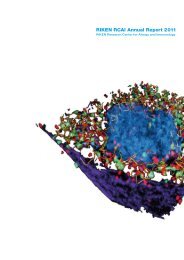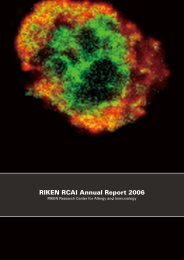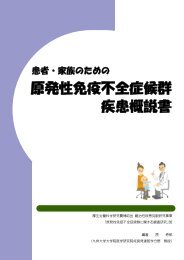in vivo
in vivo
in vivo
You also want an ePaper? Increase the reach of your titles
YUMPU automatically turns print PDFs into web optimized ePapers that Google loves.
Laboratory for<br />
Lymphocyte Development<br />
Dur<strong>in</strong>g hematopoiesis, pluripotent<br />
hematopoietic stem cells (HSC) become<br />
sequentially restricted <strong>in</strong> their developmental<br />
potential to give rise to a variety of l<strong>in</strong>eagecommitted<br />
progenitors. The major aim of the<br />
Laboratory for Lymphocyte Development is to<br />
elucidate the molecular mechanisms that regulate<br />
cell fate decisions <strong>in</strong> the process of l<strong>in</strong>eage<br />
restriction from HSC to unipotent progenitors.<br />
We have previously established a clonal assay<br />
system that makes it possible to exam<strong>in</strong>e the<br />
developmental potential of <strong>in</strong>dividual progenitor<br />
cells toward T, B and myeloid cell l<strong>in</strong>eages. This<br />
work has led to a fundamental redef<strong>in</strong>ition of the<br />
nature of lymphoid progenitors and the ontogeny<br />
and phylogeny of T- and B-cell development.<br />
Process of l<strong>in</strong>eage commitment <strong>in</strong><br />
hematopoiesis<br />
Team leader<br />
Hiroshi Kawamoto<br />
Research Scientists : Tomokatsu Ikawa<br />
Kiyokazu Kakugawa<br />
Technical Staff : Rumi Satoh<br />
Student Tra<strong>in</strong>ee : Yuuki Hayashi<br />
Assistant<br />
: Misa Uenoyama<br />
Visit<strong>in</strong>g Scientists : Nagahiro M<strong>in</strong>ato<br />
Yoshimoto Katsura<br />
The classic dichotomy model of<br />
hematopoiesis postulates that the first step<br />
of differentiation from the HSC generates<br />
the common myelo-erythroid and common<br />
lymphoid progenitors (CLP) (Figure 1A). Our<br />
previous studies <strong>in</strong> fetal mice, however,<br />
<strong>in</strong>dicated that the first step of l<strong>in</strong>eage restriction<br />
of HSC is the generation of myelo-lymphoid<br />
l<strong>in</strong>eage progenitors and myelo-erythroid l<strong>in</strong>eage<br />
progenitors (Figure 1B). Most notably , the myeloid<br />
potential is reta<strong>in</strong>ed even after the segregation<br />
of myelo-lymphoid progenitor towards T and B<br />
cell l<strong>in</strong>eages. Thus, each process of specification<br />
towards T, B and erythroid l<strong>in</strong>eages appears to<br />
proceed accompany<strong>in</strong>g the prototypical myeloid<br />
program. Recently we have termed this model<br />
the “myeloid-based model”. The concept of<br />
the CLP has, however, persisted <strong>in</strong> models<br />
of adult hematopoiesis, s<strong>in</strong>ce several groups<br />
have provided experimental results support<strong>in</strong>g<br />
the presence of CLP <strong>in</strong> the bone marrow.<br />
We have been analyz<strong>in</strong>g the developmental<br />
potential of progenitors <strong>in</strong> adult mice, and have<br />
recently obta<strong>in</strong>ed evidence <strong>in</strong>dicat<strong>in</strong>g that the<br />
myeloid-based model is also applicable to adult<br />
hematopoiesis (Wada et al, Nature, 2008).<br />
Progenitors for thymic epithelial cells <strong>in</strong><br />
adult thymus<br />
We are also <strong>in</strong>terested <strong>in</strong> the development<br />
of thymic epithelial cells, and are now focus<strong>in</strong>g<br />
on the homeostasis of thymic epithelial cells<br />
<strong>in</strong> adult mice. Although the early steps <strong>in</strong> the<br />
generation of thymic epithelial cells have recently<br />
been documented, the postnatal development<br />
28





